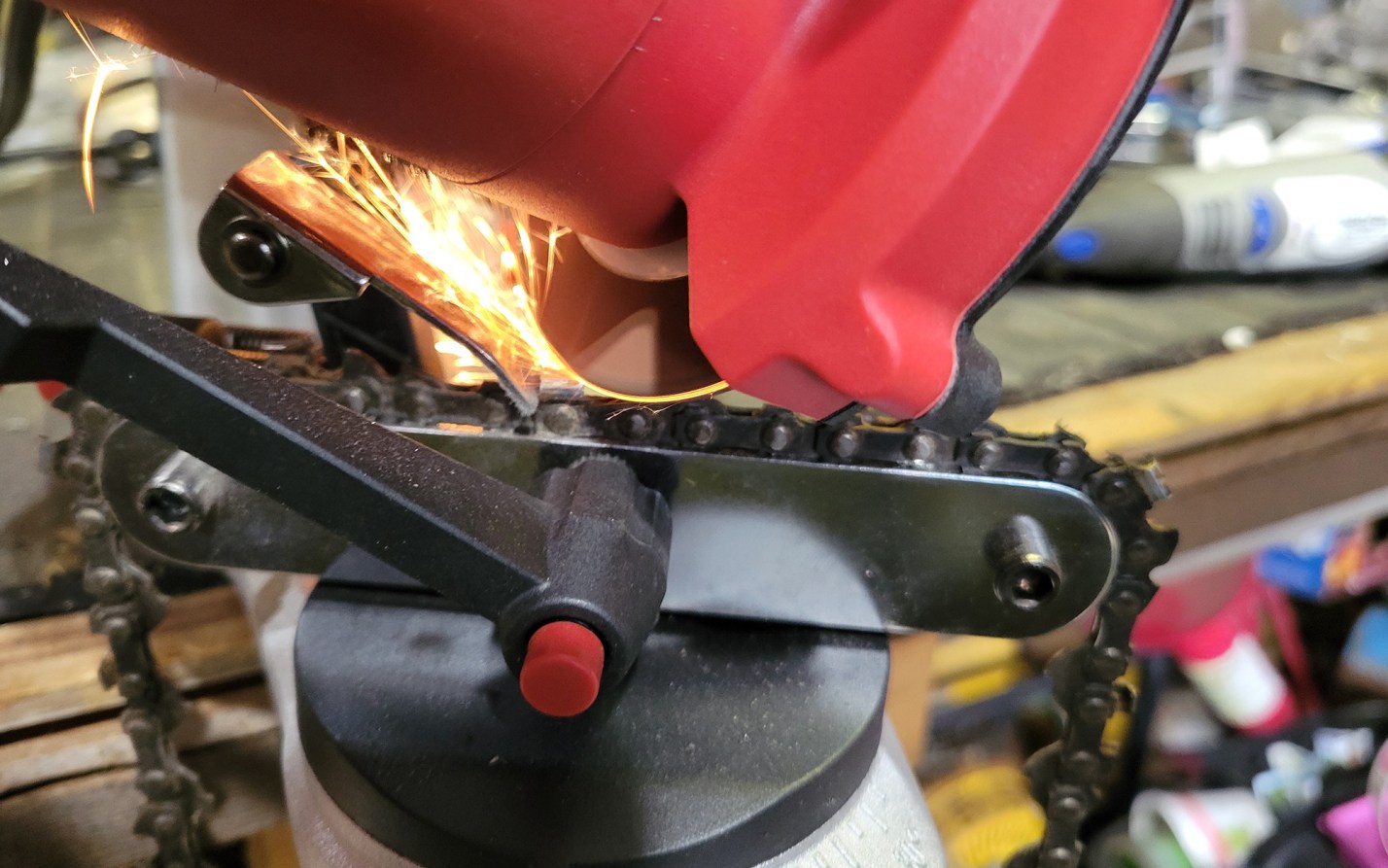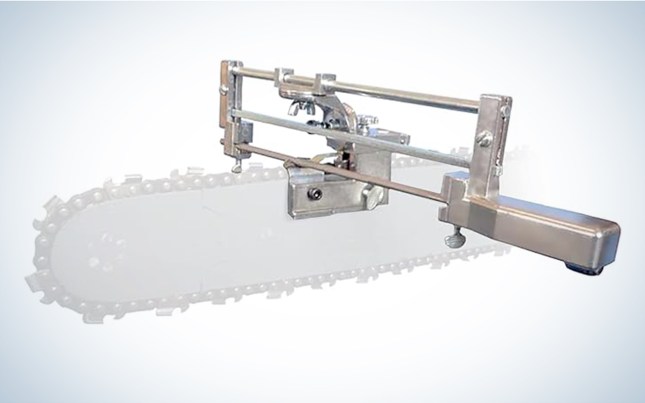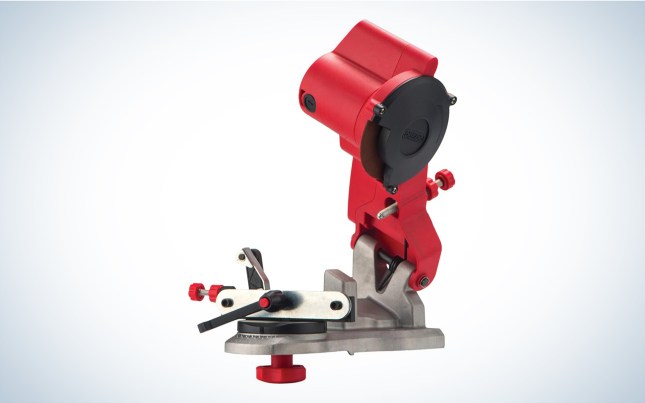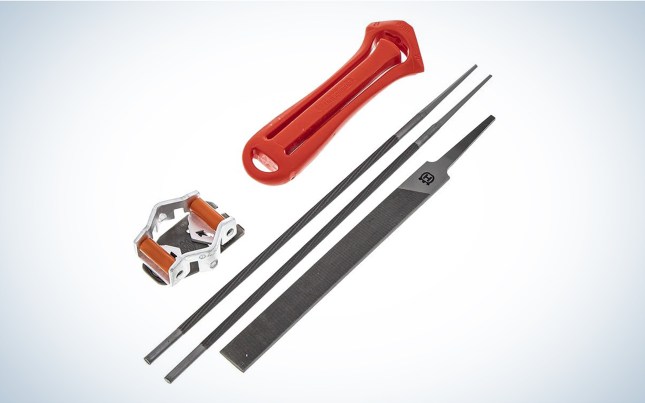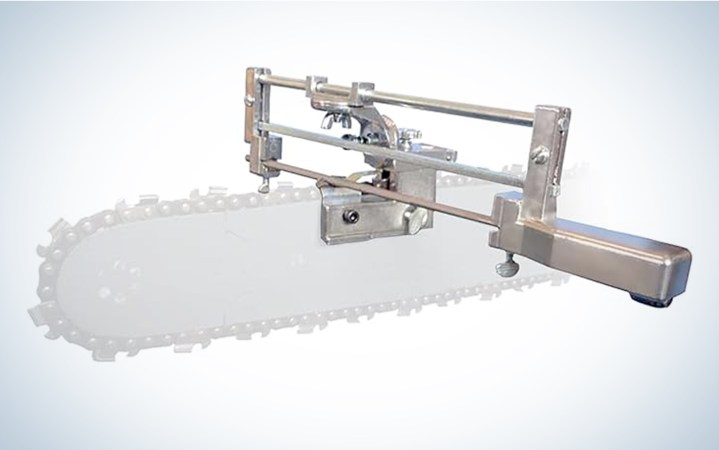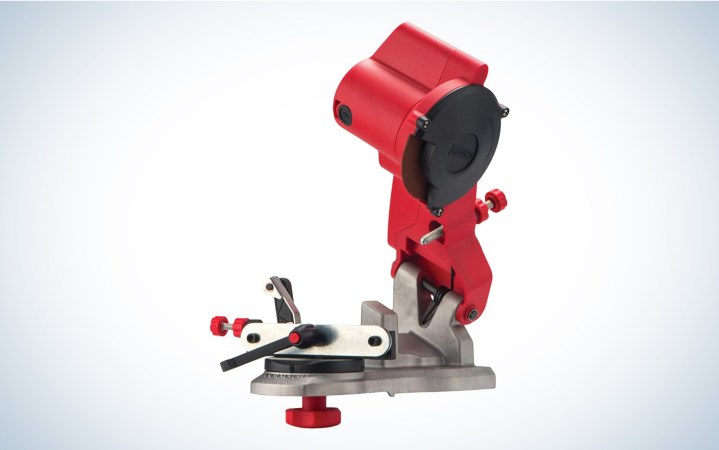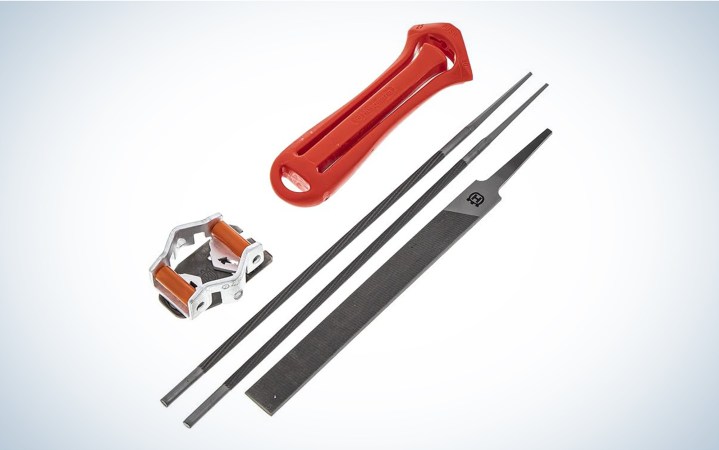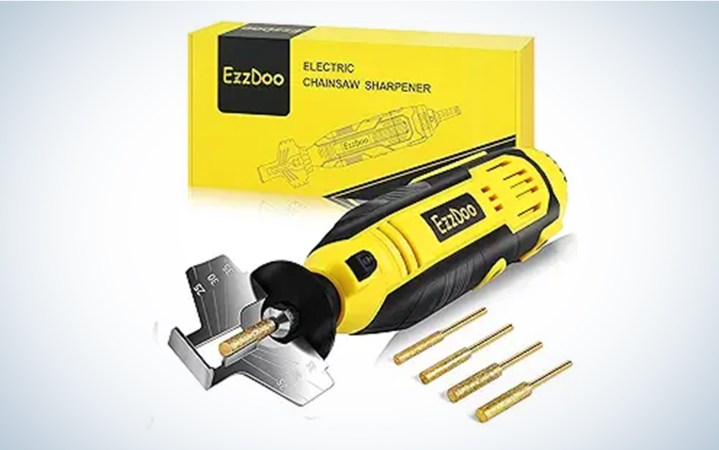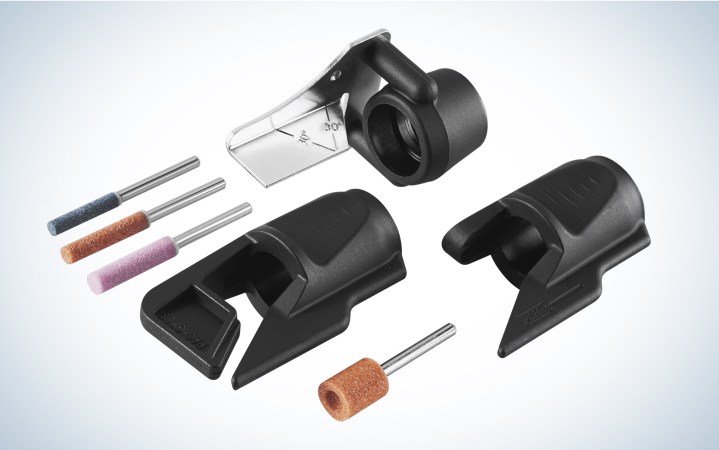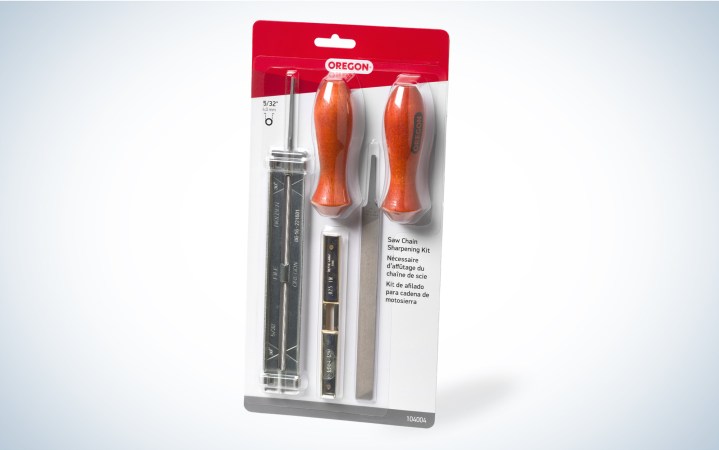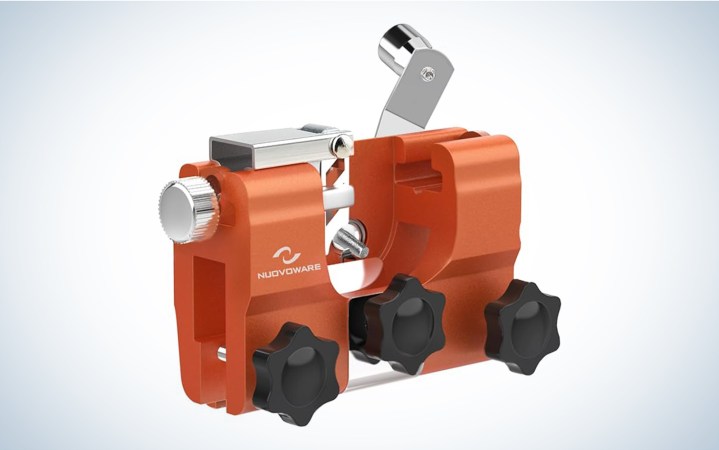We may earn revenue from the products available on this page and participate in affiliate programs. Learn More ›
Everyone who uses a chainsaw has been there: You’re at full throttle, the beautiful two-stroke symphony at max RPM, but you’re only seeing fine dust exiting the log, and you aren’t getting anywhere. Your chain is about as sharp as a marble. Some people I know go out and put a brand-new chain on, and eventually, they end up with a dozen dull chains hanging around the garage. But there is a better (and cheaper) way. Use a chainsaw sharpener.
But, a stroll through the store or a quick internet search will bring up so many options for chainsaw sharpeners that it can be hard to choose one. I tested some of the best chainsaw sharpeners to help you choose the right one.
- Best Overall: Granberg Intl. File-N-Joint G106-B
- Best Electric: Oregon Bench Mounted Mini Grinder
- Best Under $20: Husqvarna X-Cut SP33G File Kit
- EzzDoo Electric Chainsaw Sharpener
- Dremel A679-02 Sharpening Attachment Kit
- Oregon Chainsaw Sharpening Kit 104004
- Biggest Let-Down: Nuovoware Chainsaw Sharpener Tool
How I Tested the Best Chainsaw Sharpeners
To test these chainsaw sharpeners, I gathered my dull chains and chains from a couple of buddies who also run saws for firewood and property maintenance, and I sharpened them all. There were plenty to go around, and just about every size and style was covered, from small teeth for fine work to big rippers for fast bucking.
After that, it was a matter of following the instructions for each one and seeing how they did. One thing I found was that when I set up each sharpener and sharpened according to the instructions, all of them produced an excellent edge that gave like-new performance. Only one chainsaw sharpener tested failed to sharpen well, which I will cover later. Aside from that, I considered ease of use, set-up time, length of sharpening time, consistency, and versatility when choosing the best in each category.
Best Chainsaw Sharpeners: Reviews & Recommendations
Best Overall: Granberg Intl. File-N-Joint G106-B
Key Features
- Fully adjustable for any pitch, angle, and tooth height
- Accepts all file sizes
- Cast aluminum and zinc-plated steel construction (no plastic)
- Fast adjustments
- Made in the USA
- Price: $52
Pros
- No need to remove or loosen chain
- Very consistent sharpness and depth
- Simple mounting and adjusting
- No electricity needed
Cons
- Files sold separately
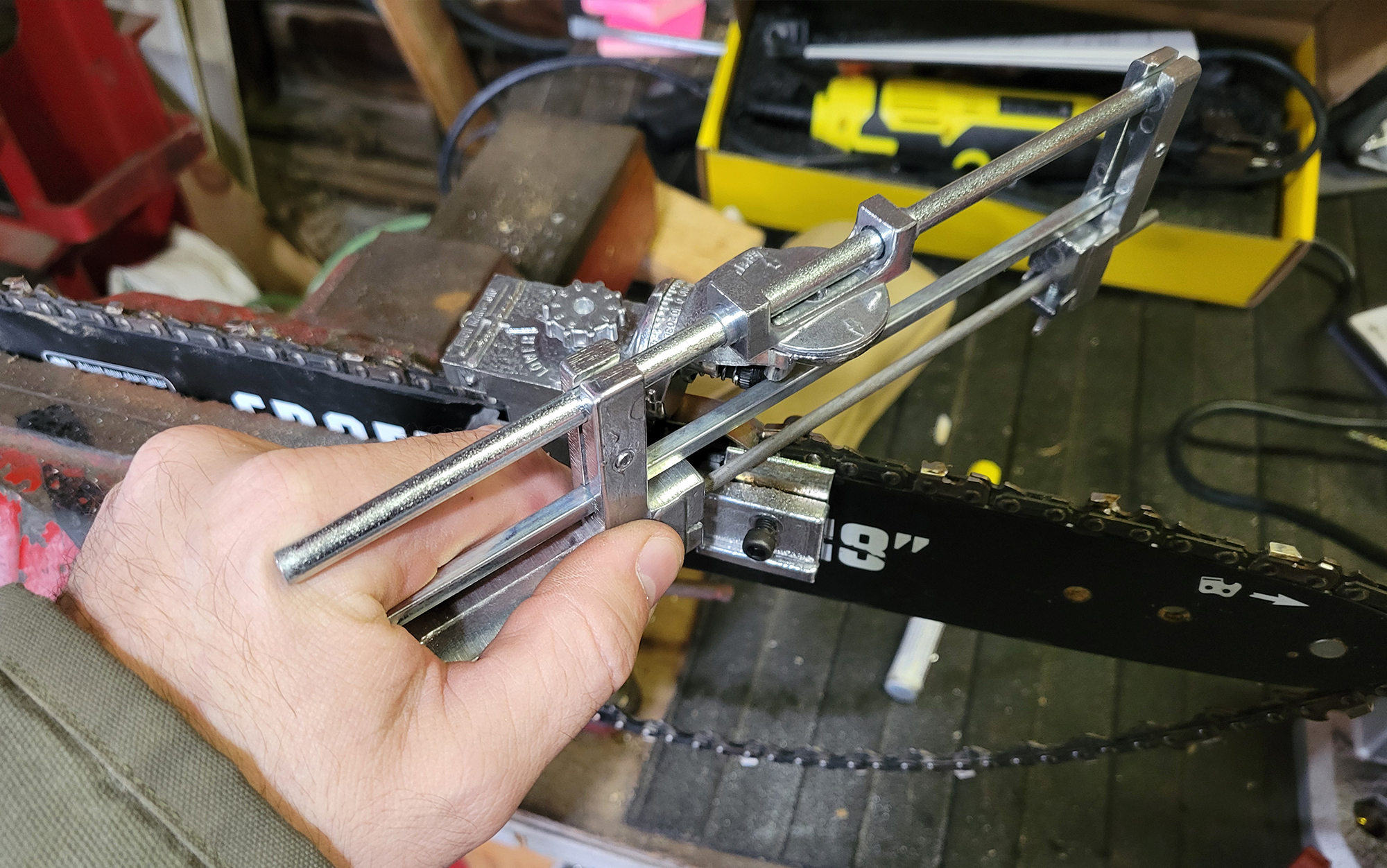
Drew Conover
The File-N-Joint almost looks a bit gimmicky at first glance, but in use, it really shines. It does everything you need it to do: It holds the chain in place, adjusts the height, pitch, and angle, and keeps you perfectly lined up so that every tooth is the same. The file holder accepts both round files for sharpening teeth and flat files for setting depth. It works well if your saw is on the bench or sitting on a stump. Because you aren’t worried about setting all the different angles of every tooth, you can move through a chain pretty quickly, and swapping from left to right is just a couple of finger adjustable wingnuts/set screws away. It’s compact enough to fit in most chainsaw cases and can go anywhere because you don’t need to plug it in. Once this is set up, it will give you good, consistent chains without the concentration and skill required to sharpen freehand. If I could have only one, I would buy the Granberg.
Read Next: Best Battery Chainsaws, Tested and Reviewed
Best Electric: Oregon Bench Mounted Mini Grinder
Key Features
- 85 Watt Motor
- Spare motor brushes included for long life
- Easy to operate
- Very consistent tooth to tooth
- Price: $100
Pros
- Removes damage faster than the rest
- Very consistent sharpness
- Simple adjustments for depth and length
- Adjustable angle
Cons
- Wheels for different tooth sizes and depth grinding wheels sold separately
- Must be mounted to a bench
The Oregon Mini Grinder manual makes it seem like there is a lot to operating it, but it really is simple and easy to use this chainsaw sharpener.
- Turn a knob to set how far down the wheel can travel so you don’t over grind.
- Turn a knob to set how much material the wheel removes from the edge.
- Rotate the lock to hold the chain, and pull down on the handle.
Once you set the knobs for the first tooth, the wheel shaves every following tooth to the set angle. Swapping from left to right is a matter of loosening a knob and twisting the chain holder to the other side, and tightening it. I wouldn’t have needed directions, but I read them anyway. A gauge comes with the grinder so that you can set the depth and choose the right wheel for your chain. You can also grind down the spare wheel with the provided dressing stone to make a flat wheel for setting depth for the chain. I didn’t bother and just used a flat file, but the option is there if you want it. Several wheels are available for the grinder, but it comes with 3.2mm and 4.7mm wheels.
Best Under $20: Husqvarna X-Cut SP33G File Kit
Key Features
- Multi-function guide is also a depth gauge
- Includes two round files and a flat file
- Depth gauge with recommended settings for softwood and hardwoods
- Price: $18
Pros
- No need to remove or loosen chain
- Rollers keep the file lined up
- Simple to use
- Easy to carry, even in a pocket
Cons
- Can’t swap files for different chains, guide only works on specified size
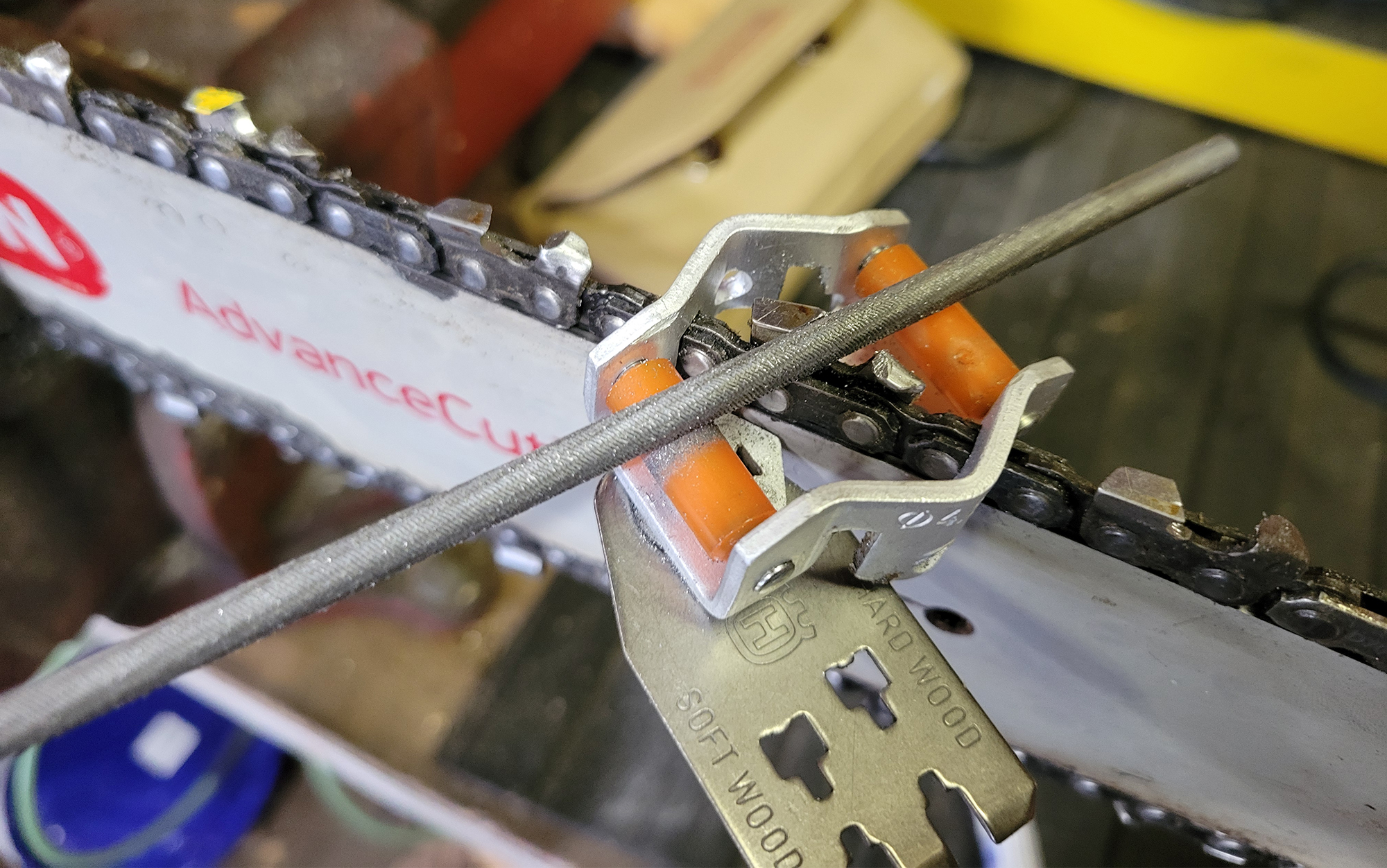
Drew Conover
This Husqvarna Kit takes the basic file kit up a notch with the roller guides, but it doesn’t cost any more than the old-school kits do. The guide snugly fits over the tooth being sharpened, and the slots set the rollers at the perfect height for the file. From there, lay the file on the rollers, parallel with the guide, and file away. A few strokes was all it took for me to bring each tooth back to life. The guide has two sets of slots cut in it for left and right teeth, and it’s as simple as turning the guide and sliding it down as before. While this is technically freehand, the rollers take much guesswork and error out of the equation. The comfortable handle will accept both round and flat files, and holds them very securely. There are other sizes available for different chains, and the only downside is that this will only work for one chain size. If you are a one-saw guy and you don’t want to spend a lot on a chainsaw sharpener, this kit will serve you very well.
EzzDoo Electric Chainsaw Sharpener
Key Features
- Guide attachment with markings for 25, 30, and 35 degrees
- Includes bit sizes for all popular chains
- Includes spare brushes for motor
- Adjustable RPM for greater control
- Price: $35
Pros
- No need to remove or loosen chain
- Diamond bits have longer life than stone style bits
- Simple to use with included guide
Cons
- Cord is quite short, will need an extension cord
- No provision for setting depth
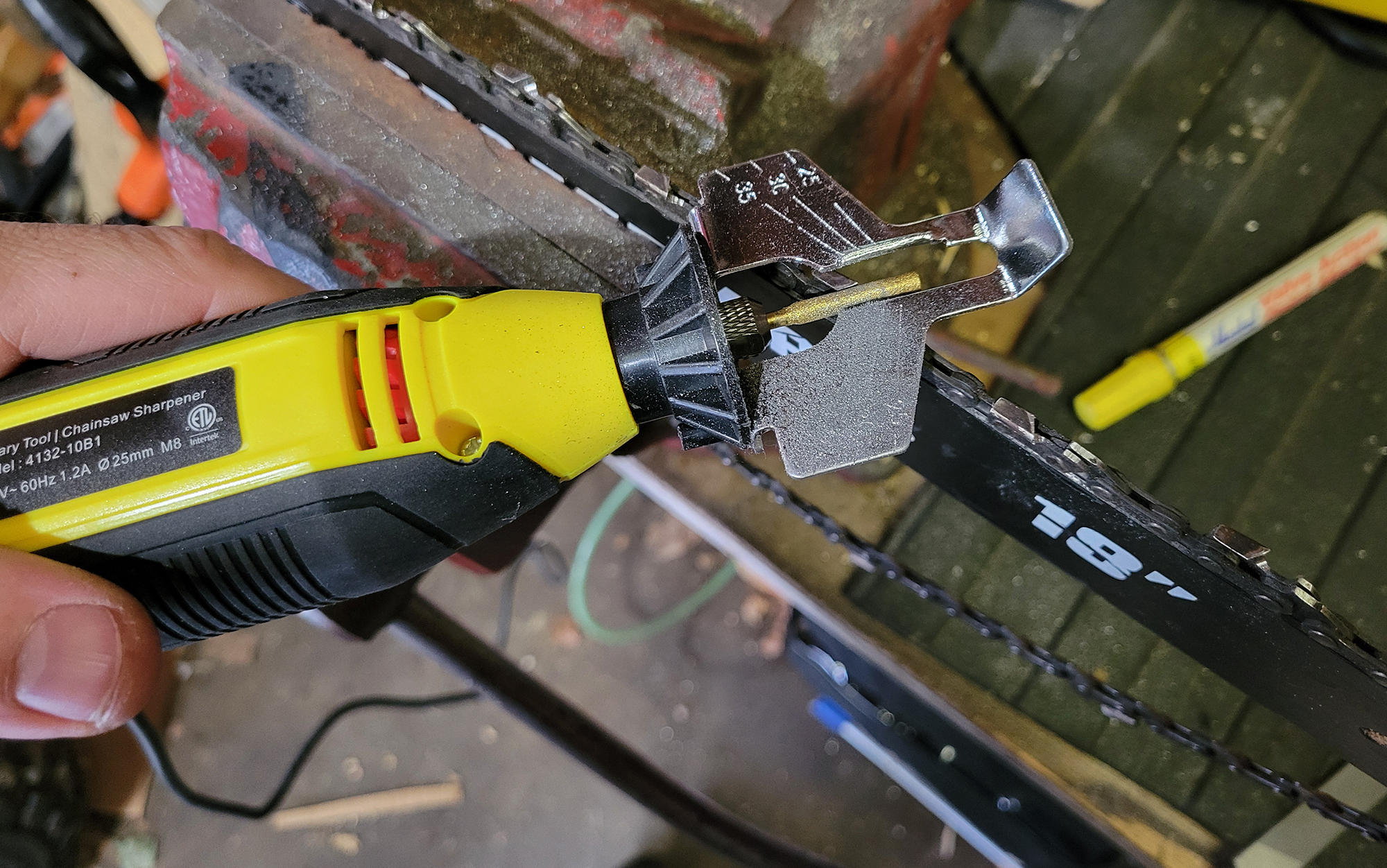
Drew Conover
The EzzDoo is essentially a Dremel Tool with a detachable guide and diamond bits specifically sized for chainsaws. It will accept Dremel Tool attachments and other bits that use Dremel-sized shanks and collets. I left the speed at the lowest setting because I didn’t want to mess things up too bad if I slipped. That being said, it still made quick work of each tooth. With two steady hands, you can get pretty consistent angles if you follow the guide closely. The cord was quite short, and even though I was only 3 feet from an outlet, I needed to use an extension cord to get the proper position. If you don’t have a Dremel tool already and want a complete package, it’s hard to beat this price and performance. The guide will help you find the correct angle, but won’t really help hold the tool in position, so if you don’t have a steady hand, this may take some practice to get solid results. You will need to have a flat file to set the depth, which is not included here. I could have used the bit and freehanded it, but it wouldn’t be consistent, which would affect performance.
Dremel A679-02 Sharpening Attachment Kit
Key Features
- Includes bit sizes for all popular chains
- Three guides included for different tools and blades
- Works with any Dremel Tool
- Price: $12- $20
Pros
- No need to remove or loosen chain
- Sharpens quickly
- Simple to use with guide
Cons
- Requires a Dremel Tool
- Stone bits seemed to wear more quickly than diamond bits
I use my Dremel for all kinds of projects around the house, and with this kit, I can add chainsaw sharpening to the list. The supplied guides work well, and I was able to actually use two of them on the chainsaw, even though one was intended for lawn mower blades. Either way, I was able to get fast results with the stone bits. I kept the speed low-medium, and only needed about a second on each tooth.
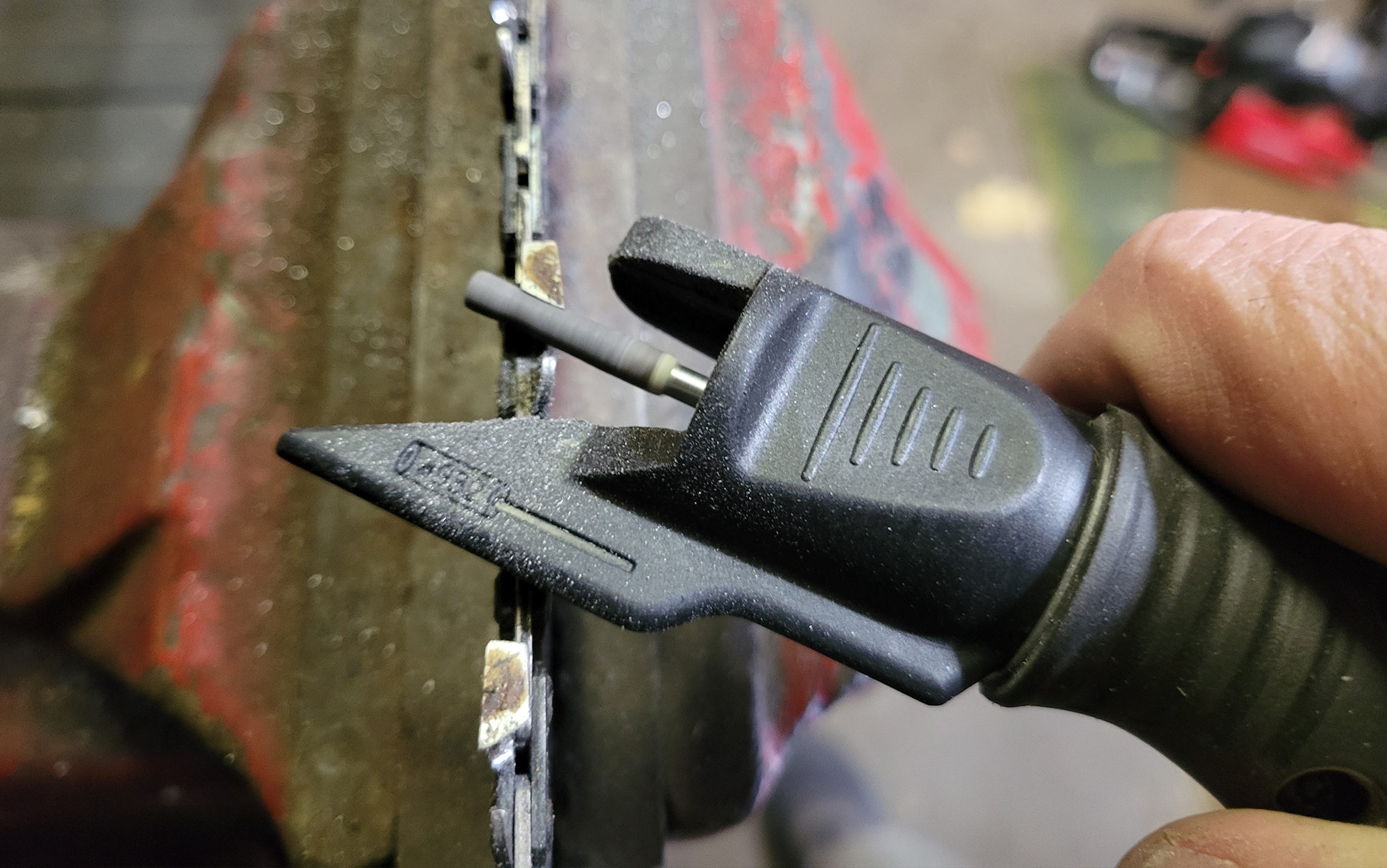
I spent more time making sure I was lined up before touching than I did removing material. However, the bits did show signs of wear after just one chain, which was a little concerning. Also, I noticed accelerated wear if the rotation of the tool was “into” the top of the tooth. Changing what side the tool was on corrected that, but the bits still looked used. If you already have a Dremel Tool, then this kit is a great addition and will serve well for occasional sharpening. I would look elsewhere if you need to sharpen often, or a high volume of chains.
Read Next: Best Electric Knife Sharpeners
Oregon Chainsaw Sharpening Kit 104004
Key Features
- Comes with two round files and a flat file
- Angle guide and depth gauge included
- Comfortable wood handles for files
- Price: $20
Pros
- No need to remove or loosen chain
- Consistent sharpness and depth
- Simple to use and easy to carry
- Angle guide clips to file for consistency
Cons
- Different kit needed for each size chain
My first chainsaw sharpener was just a plain Oregon file with no guides, and I learned how to sharpen chains the hard way. Looking back, I should have just gotten this kit for an extra 10 bucks. The angle guide, depth gauge, and flat file make sharpening faster and easier. I can get a sharp chain with just a file, but I can do it faster and with less effort with this kit.
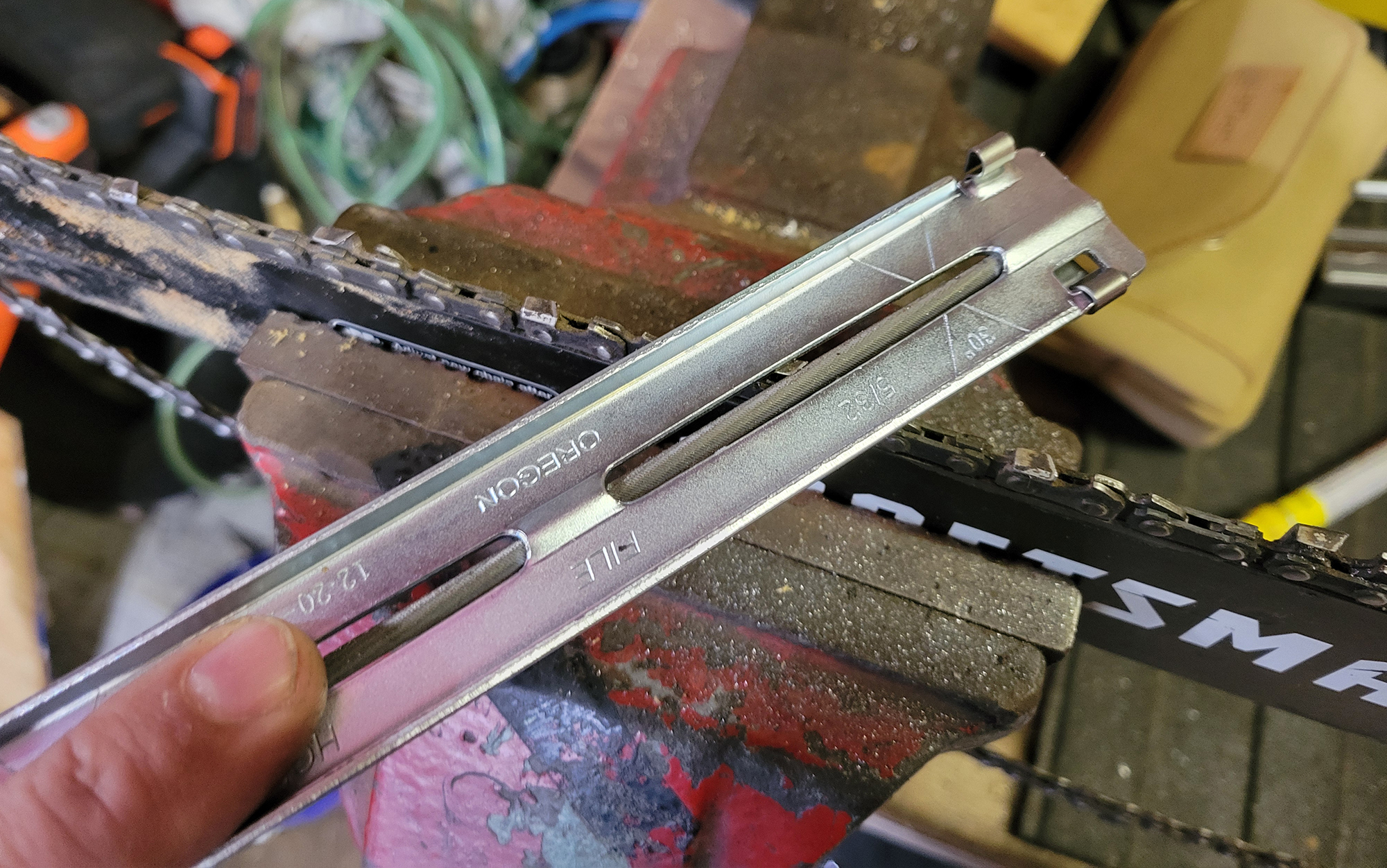
Drew Conover
The only reason this didn’t take top spot in the under $20 category was because the guide doesn’t keep you level like the Husqvarna does. But this kit does have the best depth gauge out of the bunch. I have used Oregon bars and chains and have not been let down, and the same is true with this sharpening kit. Included in the kit are two wooden handles so that you can have a handle on a round file and the flat file at the same time, which is nice so that you don’t have to switch back and forth. With a little practice, you’ll have nice sharp chains using the Oregon Kit.
Biggest Let-Down: Nuovoware Chainsaw Sharpener Tool
Key Features
- Clamps on the bar
- Aluminum and steel construction
- Compact
- Hand crank, no need for electricity
- Price: $22
Pros
- No need to remove or loosen chain
- Simple mounting
- No electricity needed
Cons
- Set at 30 degrees, not adjustable
- Chain holder set screw failed
- Difficult to get correct height
Several companies are making chainsaw sharpeners in this style (nearly identical looking), and perhaps another one may have done very well, but this one wouldn’t hold up for more than a few teeth. The screw that sets the forward and aft positioning arm indexes off of a small aluminum plate that is held by a set screw, and the set screw just doesn’t have the necessary purchase to keep the plate in place. I tried several times to get it to stay and tighten the set screw, but to no avail. Aside from that, the diamond “file” didn’t have enough taper to get started and still had some resistance when it reached full depth. It was spinning, but not removing material. I tried for about 20 minutes to get it set up so it would actually sharpen the whole tooth before taking it off the saw and “setting” it aside. Perhaps another company has perfected this design, because it seems like it should work, but the Nuovoware version isn’t worth the hassle.
Read Next: Best Electric Chainsaws
How to Choose the Best Chainsaw Sharpener for You
Chain Size
The first consideration in choosing a chainsaw sharpener is getting the correct size for the chain you have. Find the size of your chain and match it to the correct file or bit size. If you are buying a sharpener that includes three bits, you will just match the bit with the chain. There are also kits available that will have the three main file sizes included, which are 5/32-, 3/16-, and 7/32-inch so that you can tackle nearly any chain.
Electric vs. Manual
Electric sharpeners are nice and easy and don’t require much physical work. But, they require electricity, which is in short supply in some areas. Electric sharpeners can be a great option for use around the house or farm, but a manual sharpener is the way to go if you are out a little way and not close to power.
For me, there is also a satisfaction that comes from working with hand tools. That doesn’t really have a practical application, but for me it’s a consideration. Also, it’s a good idea to have a chainsaw sharpener that isn’t electric even if your main one is because many times, saws are pressed into service in emergencies like heavy snowfall or bad storms that can knock the power out.
Price
Price is a concern for most people, though none of the best chainsaw sharpeners are too terribly expensive, especially when compared to new chains or the purchase of a saw. That being said, if you need to save some money, even these sub- $20 options are great, and in your use case, may be preferable over a more expensive option. But, if you’re going manual, the Granberg is totally worth the extra money in my opinion.
Read Next: How to Sharpen a Chainsaw
FAQ
Yes, but you probably shouldn’t. Files only cut one way, and in my experience, they stay sharper longer if you are only pushing them into the cut. Pulling them backwards, especially with pressure on them, will dull them more quickly and frustrate you. Push, lift, reset, and push.
I try to keep everything consistent and file the left and right teeth the same way, meaning from the outside to the inside. I have gone from the inside out, and outside in, and haven’t seen a real difference in performance. The key is to just be consistent from tooth to tooth.
Yes. Every time a chain is sharpened, material is removed. At some point, the tooth will be too thin and too low. Some chains have lines on them that show the wear limit. If it doesn’t, you should be able to go to the manufacturer website or call them to find a measurement. If you are sharpening properly and taking just the minimum needed, your chain should last a long time.
This could be a couple things, but it’s usually because the left and right teeth aren’t sharpened the same. When I started sharpening, I thought my bar was twisted, but it turns out I was sharpening incorrectly. This is why consistency is so important, and guided systems are good. When I corrected my sharpening, my cuts were straight again.
Read Next: Best Chainsaw Chaps
Final Thoughts on the Best Chainsaw Sharpeners
A sharp chainsaw is a joy to work with, and thankfully, there are several great options to keep your chain in tip-top shape. Sharp chains also make your cutting easier and faster, so keeping your chain sharp is a worthwhile endeavor. No matter which of the best chainsaw sharpeners you choose, I recommend practicing with it before you really need it. It’s not fun learning that you need more practice when you’re in a pinch, so stay sharp.
- Best Overall: Granberg Intl. File-N-Joint G106-B
- Best Electric: Oregon Bench Mounted Mini Grinder
- Best Under $20: Husqvarna X-Cut SP33G File Kit
- EzzDoo Electric Chainsaw Sharpener
- Dremel A679-02 Sharpening Attachment Kit
- Oregon Chainsaw Sharpening Kit 104004
- Biggest Let-Down: Nuovoware Chainsaw Sharpener Tool
